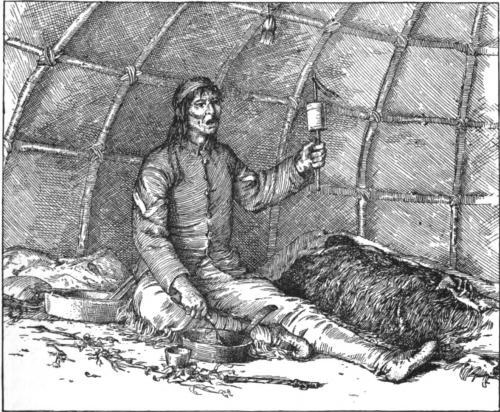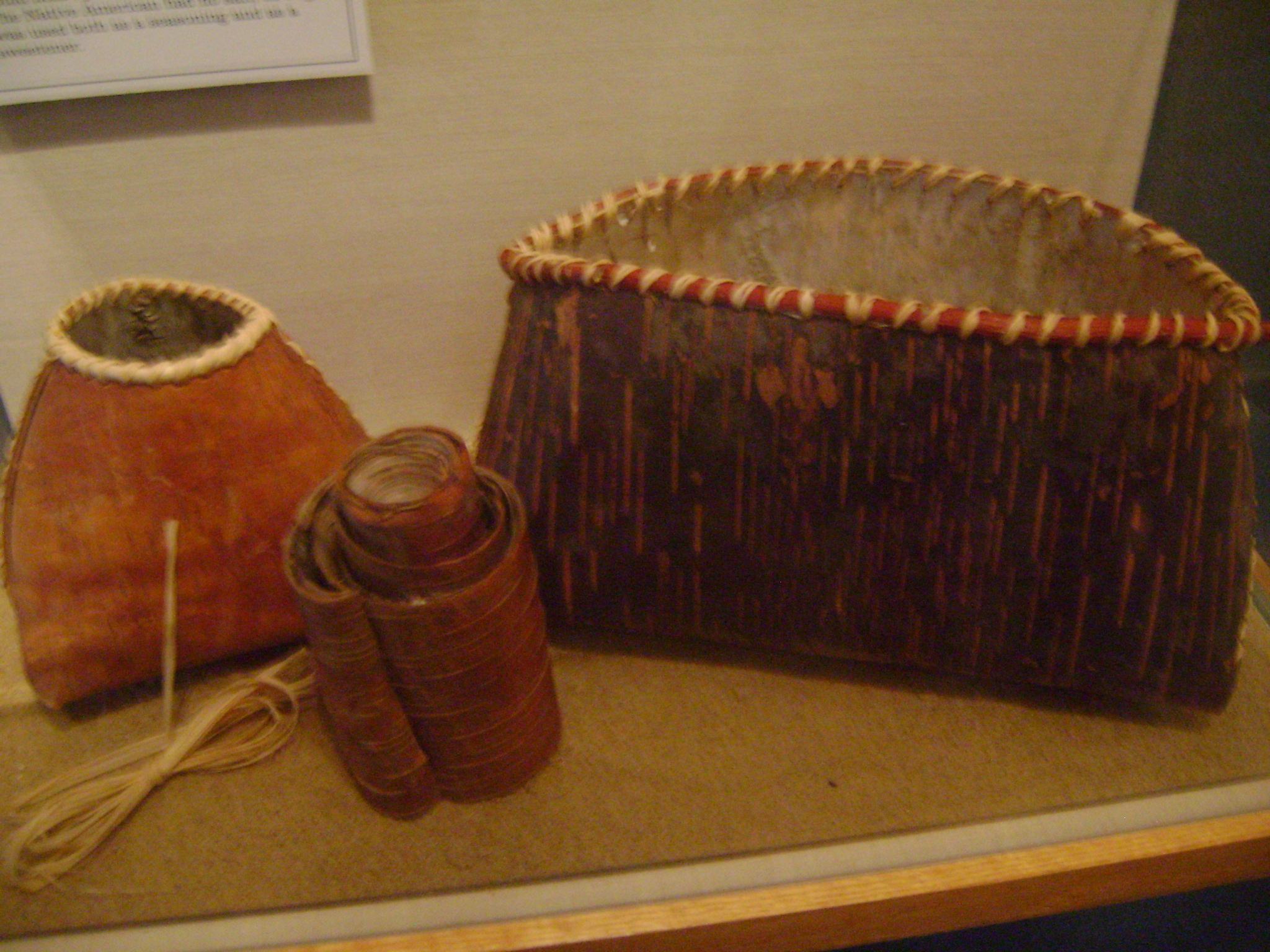|
Wiigwaasabak
''Wiigwaasabak'' (in Anishinaabe syllabics: , plural: ''wiigwaasabakoon'' ) are birch bark scrolls, on which the Ojibwa (Anishinaabe) people of North America wrote complex geometrical patterns and shapes, also known as a "written language." When used specifically for Midewiwin ceremonial use, these scrolls are called ''mide-wiigwaas'' (in syllabics: ). These enabled the memorization of complex ideas, and passing along history and stories to succeeding generations. Several such scrolls are in museums, including one on display at the Smithsonian Museum in Washington, DC. In addition to birchbark, copper, and slate may have also been used, along with hides, pottery, and other artifacts. Some archaeologists are presently trying to determine the exact origins, dates, and locations of their use. Many scrolls were hidden away in caves and man-made pits. Construct The bark of the paper birch tree provides an excellent writing material. Usually, a stylus of either bone, metal or ... [...More Info...] [...Related Items...] OR: [Wikipedia] [Google] [Baidu] |
Midewiwin
The Midewiwin (in syllabics: , also spelled ''Midewin'' and ''Medewiwin'') or the Grand Medicine Society is a secretive religion of some of the indigenous peoples of the Maritimes, New England and Great Lakes regions in North America. Its practitioners are called ''Midew'', and the practices of ''Midewiwin'' are referred to as ''Mide''. Occasionally, male ''Midew'' are called ''Midewinini'', which is sometimes translated into English as "medicine man". Etymology The preverb ''mide'' can be translated as "mystery," "mysterious," "spiritual," "sanctified," "sacred," or "ceremonial", depending on the context of its use. The derived verb ''midewi'', thus means "be in/of ''mide''." The derived noun ''midewiwin'' then means "state of being in ''midewi''." Often ''mide'' is translated into English as "medicine" (thus the term ''midewinini'' "medicine-man") though ''mide'' conveys the idea of a spiritual medicine, opposed to ''mashkiki'' that conveys the idea of a physical medicine. ... [...More Info...] [...Related Items...] OR: [Wikipedia] [Google] [Baidu] |
Ojibwe Syllabics
Ojibwe is an indigenous language of North America from the Algonquian language family. Ojibwe is one of the largest Native American languages north of Mexico in terms of number of speakers and is characterized by a series of dialects, some of which differ significantly. The dialects of Ojibwe are spoken in Canada from southwestern Quebec, through Ontario, Manitoba and parts of Saskatchewan, with outlying communities in Alberta and British Columbia,Nichols, John, 1980, pp. 1-2 and in the United States from Michigan through Wisconsin and Minnesota, with a number of communities in North Dakota and Montana, as well as migrant groups in Kansas and Oklahoma. The absence of linguistic or political unity among Ojibwe, Ojibwe-speaking groups is associated with the relative autonomy of the regional dialects of Ojibwe. There is no single dialect that is considered the most prestigious or most prominent, and no standard writing system used to represent all dialects. Ojibwe dialects have b ... [...More Info...] [...Related Items...] OR: [Wikipedia] [Google] [Baidu] |
Wiigwaasi-makak
A wiigwaasi-makak (plural: ''wiigwaasi-makakoon''), meaning "birch-bark box" in the Anishinaabe language, is a box made of panels of birchbark sewn together with watap. The construction of ''makakoon'' from birchbark was an essential element in the culture of the Anishinaabe people and other members of the Native Americans and First Nations of the Upper Great Lakes, particularly in the regions surrounding Lake Superior. Birchbark ''makakoon'' continue to be crafted to this day as heritage heirlooms and for the tourist trade. Lake Superior-area geology is short in supplies of clay, making pottery scarce for the people who lived there. However, the paper birch grows in profusion in this area, and sheets and panels of its strong, papery bark can be cut and carved from a tree for use. Birchbark boxes played a key role in creating durable packages and utensils for storage and everyday use. Skilled harvesting of the bark, done at the proper season of the year, does not fatally i ... [...More Info...] [...Related Items...] OR: [Wikipedia] [Google] [Baidu] |
Anishinaabe
The Anishinaabeg (adjectival: Anishinaabe) are a group of culturally related Indigenous peoples present in the Great Lakes region of Canada and the United States. They include the Ojibwe (including Saulteaux and Oji-Cree), Odawa, Potawatomi, Mississaugas, Nipissing and Algonquin peoples. The Anishinaabe speak ''Anishinaabemowin'', or Anishinaabe languages that belong to the Algonquian language family. At the time of first contact with Europeans they lived in the Northeast Woodlands and Subarctic, and some have since spread to the Great Plains. The word Anishinaabe translates to "people from whence lowered". Another definition refers to "the good humans", meaning those who are on the right road or path given to them by the Creator Gitche Manitou, or Great Spirit. Basil Johnston, an Ojibwe historian, linguist, and author wrote that the term's literal translation is "Beings Made Out of Nothing" or "Spontaneous Beings". The Anishinaabe believe that their people were created ... [...More Info...] [...Related Items...] OR: [Wikipedia] [Google] [Baidu] |
Ojibwe Writing Systems
Ojibwe is an indigenous language of North America from the Algonquian language family. Ojibwe is one of the largest Native American languages north of Mexico in terms of number of speakers and is characterized by a series of dialects, some of which differ significantly. The dialects of Ojibwe are spoken in Canada from southwestern Quebec, through Ontario, Manitoba and parts of Saskatchewan, with outlying communities in Alberta and British Columbia,Nichols, John, 1980, pp. 1-2 and in the United States from Michigan through Wisconsin and Minnesota, with a number of communities in North Dakota and Montana, as well as migrant groups in Kansas and Oklahoma. The absence of linguistic or political unity among Ojibwe-speaking groups is associated with the relative autonomy of the regional dialects of Ojibwe. There is no single dialect that is considered the most prestigious or most prominent, and no standard writing system used to represent all dialects. Ojibwe dialects have been wr ... [...More Info...] [...Related Items...] OR: [Wikipedia] [Google] [Baidu] |
Legendary Creature
A legendary creature (also mythical or mythological creature) is a type of fictional entity, typically a hybrid, that has not been proven and that is described in folklore Folklore is shared by a particular group of people; it encompasses the traditions common to that culture, subculture or group. This includes oral traditions such as tales, legends, proverbs and jokes. They include material culture, ranging ... (including myths and legends), but may be featured in historical accounts before modernity. In the classical era, monstrous creatures such as the Cyclops and the Minotaur appear in heroic tales for the protagonist to destroy. Other creatures, such as the unicorn, were claimed in accounts of natural history by various scholars of antiquity. Some legendary creatures have their origin in traditional mythology and were believed to be real creatures, for example dragons, griffins, and unicorns. Others were based on real encounters, originating in garbled accounts of ... [...More Info...] [...Related Items...] OR: [Wikipedia] [Google] [Baidu] |
Birch Bark Document
Birch bark manuscripts are documents written on pieces of the inner layer of birch bark, which was commonly used for writing before the advent of mass production of paper. Evidence of birch bark for writing goes back many centuries and in various cultures. The oldest dated birch bark manuscripts are numerous Gandhāran Buddhist texts from approximately the 1st century CE, from what is now Afghanistan. They contain among the earliest known versions of significant Buddhist scriptures, including a '' Dhammapada'', discourses of Buddha that include the ''Rhinoceros Sutra'', Avadanas and Abhidharma texts. Sanskrit birch bark manuscripts written with Brahmi script have been dated to the first few centuries CE. Several early Sanskrit writers, such as Kālidāsa (c. 4th century CE), Sushruta (c. 3rd century CE), and Varāhamihira (6th century CE) mention the use of birch bark for manuscripts. The bark of '' Betula utilis'' (Himalayan Birch) is still used today in India and Nepal for ... [...More Info...] [...Related Items...] OR: [Wikipedia] [Google] [Baidu] |
Mazinibaganjigan
Birchbark biting (Ojibwe: Mazinibaganjigan, plural: mazinibaganjiganan) is an Indigenous artform made by Anishinaabeg, including Ojibwe people,Indigenous Perspectives of North America: A Collection of Studies'. Cambridge Scholars Publishing; 20 August 2014. . p. 210–. Potawatomi, and Odawa, as well as CreeNative American Almanac: More Than 50,000 Years of the Cultures and Histories of Indigenous Peoples'. Visible Ink Press; 18 April 2016. . p. 1273–. and other Algonquian peoples of the Subarctic and Great Lakes regions of Canada and the United States. Artists bite on small pieces of folded birch bark to form intricate designs. Indigenous artists used birchbark biting for entertaining in storytelling and to create patterns for quillwork and other art forms. In the 17th century, Jesuits sent samples of this artform to Europe, where it had been previously unknown. The practice remained common in Saskatchewan into the 1950s. Name Birchbark biting is also known as ''mazinashkwemaga ... [...More Info...] [...Related Items...] OR: [Wikipedia] [Google] [Baidu] |
Canoe
A canoe is a lightweight narrow water vessel, typically pointed at both ends and open on top, propelled by one or more seated or kneeling paddlers facing the direction of travel and using a single-bladed paddle. In British English, the term ''canoe'' can also refer to a kayak, while canoes are called Canadian or open canoes to distinguish them from kayaks. Canoes were developed by cultures all over the world, including some designed for use with sails or outriggers. Until the mid-19th century, the canoe was an important means of transport for exploration and trade, and in some places is still used as such, sometimes with the addition of an outboard motor. Where the canoe played a key role in history, such as the Northern United States, Canada, and New Zealand, it remains an important theme in popular culture. Canoes are now widely used for competition and pleasure, such as racing, whitewater, touring and camping, freestyle and general recreation. Canoeing has been part ... [...More Info...] [...Related Items...] OR: [Wikipedia] [Google] [Baidu] |



